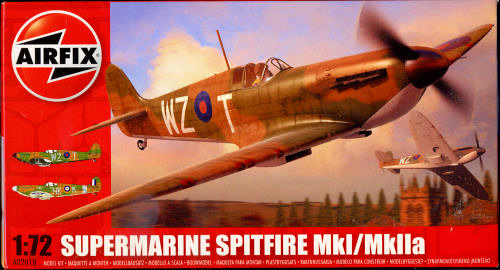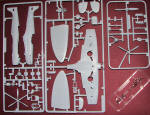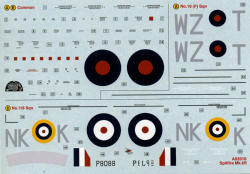
Airfix 1/72 Spitfire I/II
| KIT #: | A02010 |
| PRICE: | $7.99 SRP |
| DECALS: | Two options |
| REVIEWER: | Scott Van Aken |
| NOTES: | New tool kit |

| HISTORY |
Most of us know about the first version of the Spitfire. Here is a brief look at the Mark II.
In the summer of 1939 an early Mk I K9788 was fitted with a new version of the Merlin, the XII. With the success of the trial it was decided to use this version of the Merlin in the Mk II which, it was decided, would be the first version to be produced exclusively by the huge new Lord Nuffield shadow factory at Castle Bromwich.
Chief among the changes was the upgraded 1,175 horsepower (876 kW) Merlin XII engine. This engine included a Coffman engine starter, instead of the electric system of earlier and some later versions of the Merlin, and it required a small "teardrop" blister on the forward starboard cowling. The Merlin XII was cooled by a 70% to 30% water glycol mix, rather than pure glycol used for earlier Merlin versions.
In early 1940 Spitfire Is of 54 and 66 Squadrons were fitted with Rotol manufactured wide-bladed propellers of 10 ft 9 in (3.27 m) diameter, which were recognizable by a bigger, more rounded spinner: the decision was made that the new propeller would also be used exclusively by the Mk II. This engine/propeller combination increased top speed over the late Mk I by about 6-7 mph below 17,000 feet (5,200 m), and improved climb rate. Due to all of the weight increases maximum speed performance was still lower than that of early Mk Is, but combat capability was far better. The Mk II was produced in IIA eight-gun and IIB cannon armed versions. Deliveries were very rapid, and they quickly replaced all remaining Mk Is in service, which were then sent to Operational Training Units. The RAF had re-equipped with the new version by April 1941.The Rotol propeller units were later supplemented by de Havilland constant-speed units similar to those fitted to Mk Is.
A small number of Mk IIs were converted to "Long Range" Spitfires in early 1941. These could be recognized by the fixed 40 gal (182 l) fuel tank which was fitted under the port wing. With a full tank maneuverability was reduced, maximum speed was 26 mph (42 km/h) lower and the climb rate and service ceiling were also reduced. Several squadrons used this version to provide long-range bomber escort. Once the Mk II was taken out of front line service, 50 of them were converted for air-sea rescue work, at first under the designation Mk IIC (type 375) but later referred to as the A.S.R Mk II. The Merlin XII was replaced by the Mark XX, a "rescue pack" was fitted in the flare chute and smoke marker bombs were carried under the port wing.
A total of 921 Mk IIs were built, all by Castle Bromwich. A small number of Mk IIs were converted to Mk Vs.
| THE KIT |
 Late
in previewing this one due to the lack of local availability, but I am quite
pleased with the kit so the wait was worth it. I will mention that this,
like all recent Airfix new tool kits has rather large engraved detail. The
options are to whine about it, fill it in, or just enjoy the kit as it
comes.
Late
in previewing this one due to the lack of local availability, but I am quite
pleased with the kit so the wait was worth it. I will mention that this,
like all recent Airfix new tool kits has rather large engraved detail. The
options are to whine about it, fill it in, or just enjoy the kit as it
comes.  provided,
it is available from Hornby so a wheels up option is included, using
separate bits for this. Speaking of landing gear, the main gear legs are
molded with the doors and five spoke wheels are provided.
provided,
it is available from Hornby so a wheels up option is included, using
separate bits for this. Speaking of landing gear, the main gear legs are
molded with the doors and five spoke wheels are provided. | CONCLUSIONS |
I like it. It is an inexpensive kit that provides a lot of options and previous new tool Airfix kits have built quite well with minimal fuss. Since this is now a series 2 kit, you get two markings options and a regular box. There are already quite a few aftermarket bits and decals for this kit so you should have no troubles doing something you really like.
| REFERENCES |
http://en.wikipedia.org
My thanks to, well, me for my patience in waiting for Hornby
USA to finally get enough in to fill the LHS' long outstanding order. January 2012
If you would like your product reviewed fairly and fairly quickly, please contact the editor or see other details in the Note to Contributors.